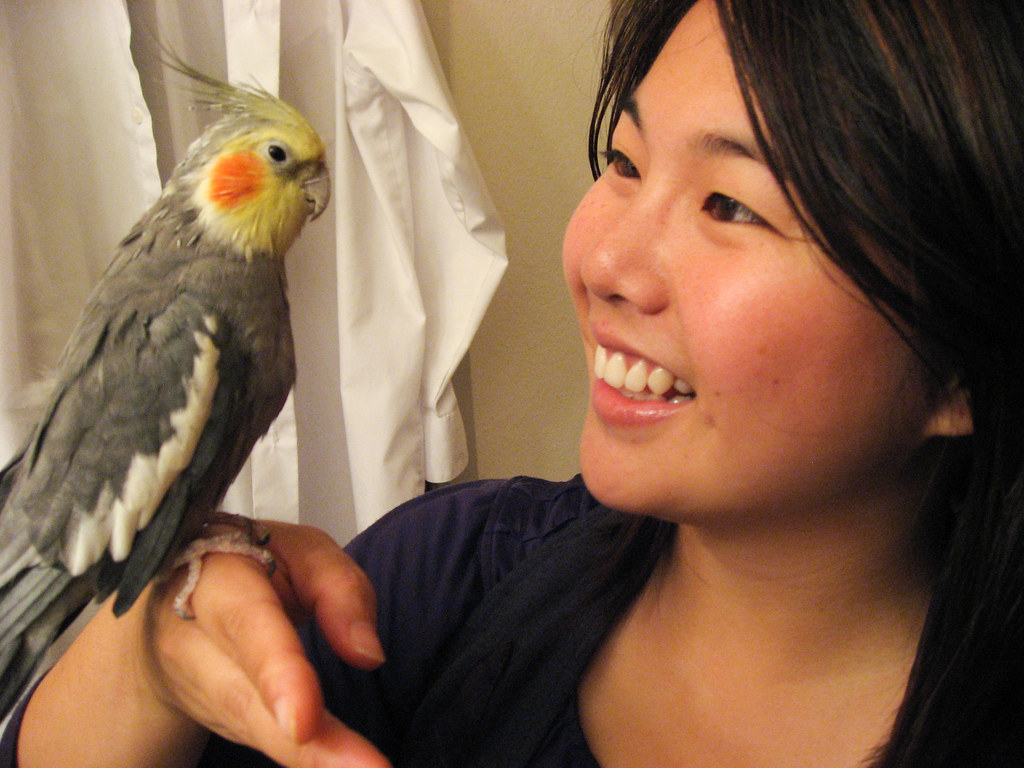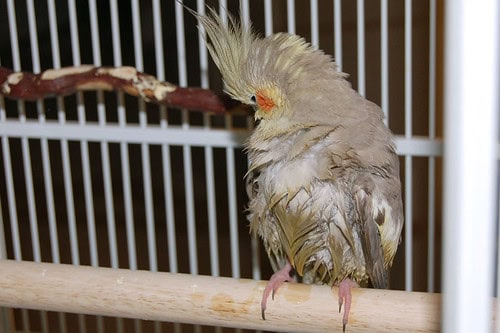Imagine the freedom of enjoying your cockatiel’s company without the constant worry of cleaning up after them. Learning how to toilet train your cockatiel isn’t just a neat trick; it’s a practical solution to enhance your life with your feathered friend. This training can strengthen your bond and significantly ease the maintenance of a clean and healthy environment for both of you.
Starting with the right approach and consistency, you can teach your cockatiel to go to the bathroom in a designated spot. This process not only keeps your home cleaner but also promotes good habits and discipline in your pet. Ready to ditch the mess and embrace a cleaner, happier living situation with your bird? Let’s dive into the steps and tips that will guide you through toilet training your cockatiel effectively.
Understanding Cockatiel Behavior

Recognizing the unique behaviors of your cockatiel is paramount when you’re embarking on toilet training. Understanding these behaviors ensures a smoother training process and fosters a stronger bond between you and your pet.
Recognizing Toilet Indicators
Cockatiels often display distinct signs before relieving themselves, which, if observed keenly, can guide you on the right training path. Look for behaviors such as squatting, becoming still, or backing up to a corner, which typically occur just before your bird is about to go. Additionally, “bird talk warns” can play a crucial role; vocalizations or specific sounds your cockatiel makes may indicate that they need to use the bathroom.
Learning these indicators helps you anticipate when to place your cockatiel over an appropriate spot, reinforcing habits conducive to training. Observe the timing of these signals, as most birds, including cockatiels, have predictable bowel movements. Remember, recognizing these signs early on not only aids in training but also minimizes the need for clean-ups.
Introducing Toilet Training Concepts
Start familiarizing your cockatiel with toilet training by linking specific cues to the bathroom routine. Use a clear verbal command like “go potty” whenever you observe your bird’s body language indicating the need to relieve itself. Position your cockatiel on a designated perch or a spot in its bird cage lined with newspaper or paper plates when issuing the command.
Consistent repetition of this routine helps your bird associate the command with the action. Reward your cockatiel with treats and verbal praise when it successfully uses the designated area. This positive reinforcement makes the learning process both enjoyable and effective.
Preparing for Training

Optimizing the training process requires preparation and understanding of your cockatiel’s needs. Equipped with the right tools and environment, you’ll set the stage for successful toilet training.
Essential Supplies for Toilet Training
Gathering the right supplies is the first step to effectively train your cockatiel. Here are the items you’ll need:
- Training Perch: Choose a stable perch where your cockatiel feels comfortable. This will be the designated “potty perch.”
- Absorbent Liners: Use newspaper or paper plates underneath the training perch to catch droppings. These materials make cleanup easier and allow you to dispose of waste quickly.
- Treats for Reward: Have small treats on hand to reward your cockatiel immediately after it follows the potty training commands successfully. This positive reinforcement helps your bird associate the act of using the designated spot with rewards.
Having these items ready before beginning the training sessions ensures you’re prepared to guide and reward your cockatiel’s behavior effectively.
Setting Up a Training Area
Creating a specific area for potty training is crucial. Here’s how to set it up:
- Select a Quiet Corner: Choose a quiet area of your home with minimal distractions. Cockatiels can concentrate better in a calm environment.
- Place the Training Perch: Install the training perch in the chosen area. Make sure it’s stable and at a comfortable height for your cockatiel.
- Line with Absorbent Materials: Position newspapers or paper plates under the perch. These should be easily accessible to you for quick cleaning and replacement.
This setup not only helps in keeping the training sessions focused and efficient but also simplifies maintenance of the area, keeping your space clean and odor-free.
- Size: 15cm x 25cm/5.9'' x 9.8''. Each perch is unique and will differ in shape (not size) from the perch pictured
- Made of high quality wood and hardware, durable
- The unique shape of the perches provides excellent foot exercise
- An ideal place designed for your friends to play and climb, easy install in the cage
- Each perch is unique, none are the same and may vary between them,thickness and bending
Training Steps
Successfully toilet training your cockatiel involves establishing a routine and using specific commands to encourage desired behaviors. Let’s dive into the effective strategies that can help streamline this process.
Establishing a Toilet Routine
Creating a consistent toilet routine is crucial for effective potty training. You’ll want to observe and document your bird’s natural bowel movements to identify patterns. Most cockatiels tend to go to the bathroom at regular intervals, making it easier to predict when it’s time. Once you’ve identified these times, consistently place your cockatiel on the designated potty spot—this could be a special perch or a piece of newspaper located in an easy-to-clean area.
Aim to do this first thing in the morning, after meals, and before bedtime. Repetition and consistency are key; by regularly placing your cockatiel in the correct spot at these times, the bird begins to associate this place with going to the bathroom.
Utilizing Commands and Cues
To streamline the training process, introduce verbal commands or simple phrases like “go potty” as you place your cockatiel on the designated spot. Speak in a clear, soft tone to avoid startling them. As your cockatiel performs the desired action, immediately offer a small treat or verbal praise. This positive reinforcement makes the experience rewarding and encourages repetition of the correct behavior.
Over time, your cockatiel will start associating the command with the action, allowing for a more controlled and predictable potty training experience. Remember, patience and persistence are vital, as it might take several weeks for your cockatiel to reliably respond to cues.
Common Challenges and Solutions
Toilet training your cockatiel isn’t without its hurdles. This section delves into the common challenges you might encounter and provides effective solutions to overcome them.
Dealing with Accidents
Accidents are a natural part of the learning process when you are toilet training your cockatiel. If your bird poop outside the designated area, it’s important to remain calm and avoid any negative reactions. Scolding your bird may cause confusion and fear, which can set back training progress.
- Immediate Cleanup: Clean up any accidents promptly using a safe, bird-friendly cleaner. This helps prevent the area from becoming a habitual spot for your cockatiel to relieve itself.
- Reinforcement of Training: After cleaning, bring your cockatiel back to the designated potty spot. This reinforces the idea of where it’s appropriate to go. Use a verbal command like “go potty” to help your bird associate the area with the action.
- Adjust Timing: Birds often need to relieve themselves at specific times, such as after eating or sleeping. Watch for these patterns and place your cockatiel on the perch during these predictable times to minimize accidents.
Common Challenges and Solutions
Toilet training your cockatiel isn’t without its hurdles. This section delves into the common challenges you might encounter and provides effective solutions to overcome them.
Dealing with Accidents
Accidents are a natural part of the learning process when you are toilet training your cockatiel. If your bird poop outside the designated area, it’s important to remain calm and avoid any negative reactions. Scolding your bird may cause confusion and fear, which can set back training progress.
- Immediate Cleanup: Clean up any accidents promptly using a safe, bird-friendly cleaner. This helps prevent the area from becoming a habitual spot for your cockatiel to relieve itself.
- Reinforcement of Training: After cleaning, bring your cockatiel back to the designated potty spot. This reinforces the idea of where it’s appropriate to go. Use a verbal command like “go potty” to help your bird associate the area with the action.
- Adjust Timing: Birds often need to relieve themselves at specific times, such as after eating or sleeping. Watch for these patterns and place your cockatiel on the perch during these predictable times to minimize accidents.
Adjusting Training Techniques
Not all training techniques will work perfectly on the first try, and adjustments might be necessary to find what best motivates your cockatiel.
- Change the Reward: If your cockatiel is not responding well to current rewards, switch them up. Some birds may prefer a small piece of fruit or a special treat, while others respond better to verbal praise or extra playtime.
- Vary the Routine: If repetitiveness seems to bore your bird, try to make training sessions varied and exciting. This could include changing the verbal cues or introducing training at different times of the day.
- Consult Professionals: If you’re struggling to make progress, consider seeking advice from a bird trainer or a vet experienced with birds. They can offer specialized insights and techniques that might be more effective for your specific situation.
By tackling these challenges with patience and adaptability, you’ll improve the likelihood of successfully potty training your cockatiel.
Additional Tips for Success
Achieving success in toilet training your cockatiel involves more than just the basic steps; fine-tuning your approach can significantly enhance the effectiveness of the training. Here, you’ll discover additional techniques to bolster your efforts and ensure your bird adapuates to the designated potty area.
Positive Reinforcement Techniques
Utilizing positive reinforcement techniques forms a cornerstone of effective toilet training for your cockatiel. Offer treats or verbal praise immediately after your bird successfully goes potty in the right spot. Cockatiels are quick to associate these positive outcomes with their actions. Integrating verbal commands like “good potty” each time your bird performs as desired, reinforces this behavior.
Gradually, your bird learns to repeat these actions for rewards, enforcing a lasting habit. Remember, consistency in the type of reward and timing is crucial for these techniques to imprint the desired behavior effectively.
Maintaining Your Training Consistency
Consistency is crucial for successfully potty training your cockatiel. Train your bird at the same times each day, particularly after meals and before bedtime, as these are typical times when cockatiels need to use the bathroom. If a session is missed, quickly resume to keep the routine intact. Make sure the potty area remains easily accessible and consistently marked.
Avoid relocating the designated spot to help your cockatiel remember and reliably use it. By maintaining this steady approach, you support your bird in developing a strong and dependable potty routine, which will help minimize accidents around your home. This consistency is key for bird owners seeking to ensure their cockatiel remains well-potty trained.
Final Thoughts: How to Toilet Train Your Cockatiel?
Toilet training your cockatiel can be a rewarding endeavor, enhancing your bond and keeping your home cleaner. Remember, the key to success lies in your consistency and patience. Stick to the training routine you’ve established and always use positive reinforcement to encourage your bird’s good behavior. With time and dedication, you’ll find that your feathered friend can learn where and when it’s appropriate to go. Embrace each small victory and learn from the mishaps along the way.
Other suggested articles:
Why Do Cockatiels Eat Their Poop?
How to Catch a Cockatiel: Tips, Tricks, and Tactics
Can an Old Cockatiel be Tamed?




